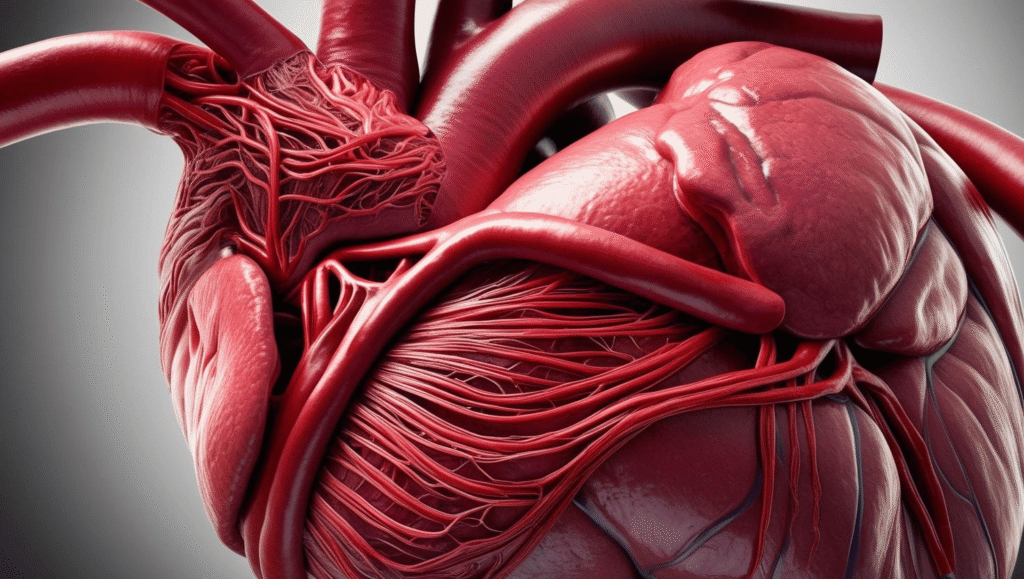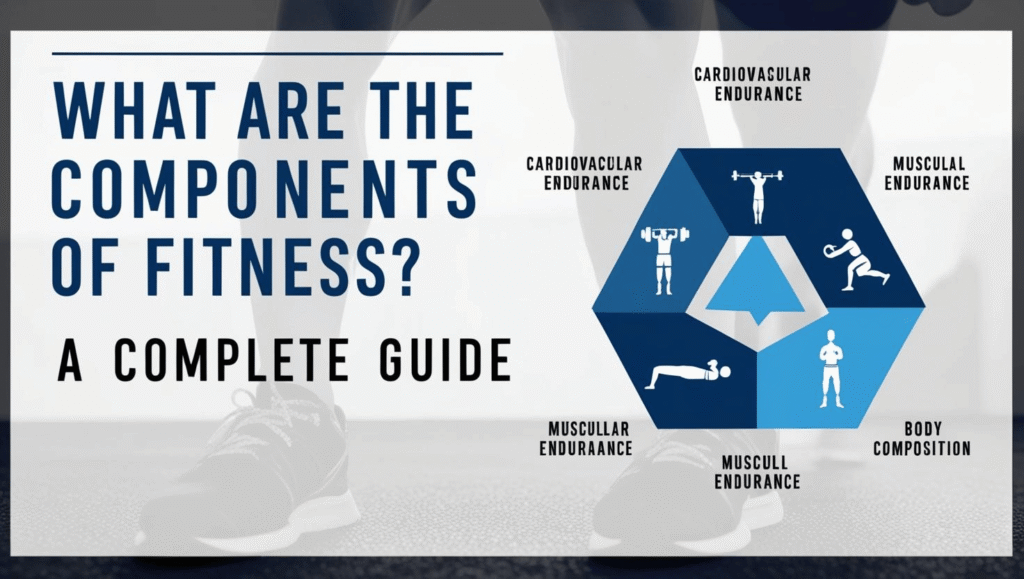Are you tired of not getting stronger? Do you want a good weightlifting plan to boost your fitness? This article will explore the best ways to lift weights for muscle and strength.
To grow muscle, you need to keep lifting weights. Lifting weights makes tiny tears in your muscles. Then, your body fixes these tears, making your muscles bigger and stronger. To grow muscles well, focus on how often you lift, how much you lift, and getting stronger over time.
Experts say to lift each muscle group 2-3 times a week. Do 3-4 sets of 8-12 reps for each exercise. Use weights that make your muscles work hard. Getting stronger over time is key for muscle growth.
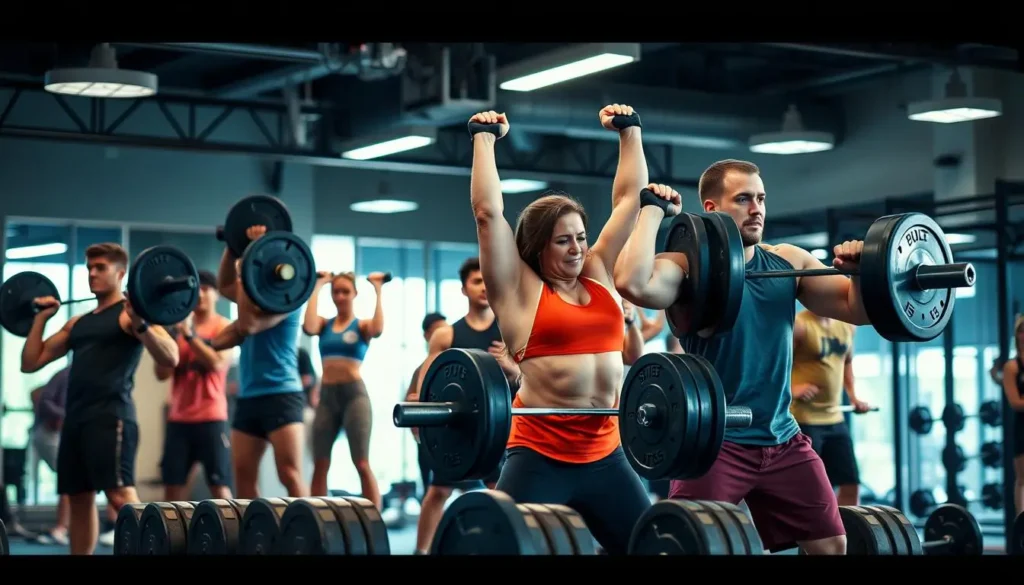
Table of Contents
Key Takeaways
- Effective weightlifting routines involve compound movements, high-repetition heavy lifting, and maximum-effort training.
- Proper rest and recovery are essential to prevent overtraining and allow for muscle growth.
- Progressive overload is the key to continuous strength and muscle gains.
- Incorporating a mix of free weights and resistance machines can maximize results.
- Nutrition plays a vital role, with a slight calorie surplus and adequate protein intake.
Fundamentals of Muscle Growth
Building muscle is a complex process. It involves growing and breaking down muscles. This process is mainly driven by progressive overload, which means you get stronger by lifting heavier weights.
By lifting heavier weights or doing more reps, your muscles get bigger and stronger. This is how you grow muscle.
Muscular Hypertrophy and Progressive Overload
Muscular hypertrophy happens when your muscles repair after strength training. This makes your muscles bigger and stronger. To grow muscles, you need to keep challenging them with more intense workouts.
Importance of Rest and Recovery
Rest and recovery are as important as training for muscle growth. Muscles need time to repair and grow after working out. If you don’t rest enough, you might get tired, hurt yourself, or feel burnt out.
Make sure to take rest days, sleep well, and eat right. This helps your muscles recover and grow.
It’s all about finding the right balance between training, rest, and eating well. Knowing how to grow muscles helps you build a good workout plan. This plan will help you reach your muscle-building goals.
“Muscle helps to regulate blood sugar levels, preventing potential long-term health issues associated with elevated blood sugar.”
Determining Training Frequency
How often you work out is very important for building muscle and getting stronger. Most experts say you should train each muscle group 2-3 times a week to grow muscles. Training less than 2 times a week might not be enough to grow muscles.
If you work out 3 times a week, it’s good to alternate between a workout day and a rest day. This lets your muscles recover well. Being consistent and frequent is key to building muscle.
- Beginners can start with 2 or 3 days of resistance training per week
- More experienced people can handle more workouts
- Beginners should wait 1 to 3 days between workouts for recovery
- Intermediate folks should aim for 3 or 4 days of training per week
- Advanced people should train 4 to 6 days a week
- Double split routines can add 4 to 6 more workouts a week for advanced folks
- Split routines help train specific muscle groups more effectively
- Advanced folks might do short workouts in one day to get more stimulus
Research shows that training a muscle group many times a week helps it grow more. It’s good to rest muscle groups for 48-72 hours before working them again. This helps them repair and recover. A mix of workout strategies and recovery is important for lasting muscle growth and health.
Choosing the Right Exercises
Choosing the right exercises is key for building muscle and getting stronger. A good weightlifting plan should focus on compound exercises. These exercises, like squats and bench presses, work many muscles at once. This helps grow muscles and get stronger.
Compound Exercises vs. Isolation Exercises
Compound exercises should be the base of your workout. They save time and work many muscles at once. Isolation exercises target specific muscles. They help fix muscle imbalances. Mixing both types makes your workout better for muscle growth and strength.
Proper Form and Technique
Good form and technique are vital for safe and effective workouts. Bad form can hurt your muscles and slow growth. Always focus on proper technique to work your muscles right.
By choosing compound exercises, using isolation exercises wisely, and focusing on form, you’ll get a great workout. This helps grow muscles and boosts fitness.

| Exercise Type | Advantages | Disadvantages |
|---|---|---|
| Compound Exercises |
- Engage multiple muscle groups
- Increase metabolic demand
- Improve aerobic endurance, muscular fitness, and flexibility
- Offer a significant return on investment in time
- May be more technically demanding
- Require more recovery time
| Isolation Exercises |
- Target specific muscle groups
- Useful for addressing imbalances
- Engage fewer muscle groups
- May not provide as much overall strength and muscle development
“Compound exercises have been found to improve aerobic endurance, muscular fitness, and flexibility.”
By mixing compound exercises with isolation exercises, you get a great workout. This boosts muscle growth, fitness, and helps avoid injuries.
Weightlifting Routines
There are many ways to set up your weightlifting workouts for muscle growth. Full-body workouts are great for those who can only train 2-3 times a week. They make sure each muscle group gets worked often, which helps muscles grow.
Full-Body Workouts
The plan is for beginners and lasts four weeks. In the first week, you train all major muscle groups in three days. You do one exercise for each body part.
In Week 1, you do a total of nine sets for each body part. You aim for 8-12 reps per set, which is good for muscle growth. The weight goes down as reps go up in Week 1.
Split Routines
Split routines are good for those who can train 4 or more times a week. They let you focus on specific muscle groups in each session, helping them grow. Popular splits include push/pull/legs, upper/lower, and body part splits.
Beginners are those new to lifting, having done it for less than a year. Intermediate lifters have been at it for at least a year. Advanced lifters have been lifting for two years or more. Rest times range from 60-90 seconds for at-home workouts.
For beginners, rest times at the gym are 90-180 seconds for main exercises and 60-90 seconds for accessories.
| Week | Training Split | Sets per Exercise | Reps per Set | Rest Intervals |
|---|---|---|---|---|
| 1 | Full-Body | 9 sets per body part | 8-12 reps | 60-90 seconds |
| 2 | Upper/Lower | 3-4 sets per exercise | 15 reps on 3rd set | 90-180 seconds for main, 60-90 seconds for accessories |
| 3 | Push/Pull/Legs | 3-4 sets for smaller body parts, 4 sets for larger | 8-12 reps | 90-180 seconds for main, 60-90 seconds for accessories |
| 4 | 4-Way Split | 4-5 sets for larger body parts, 3 sets for smaller | 8-12 reps | 90-180 seconds for main, 60-90 seconds for accessories |
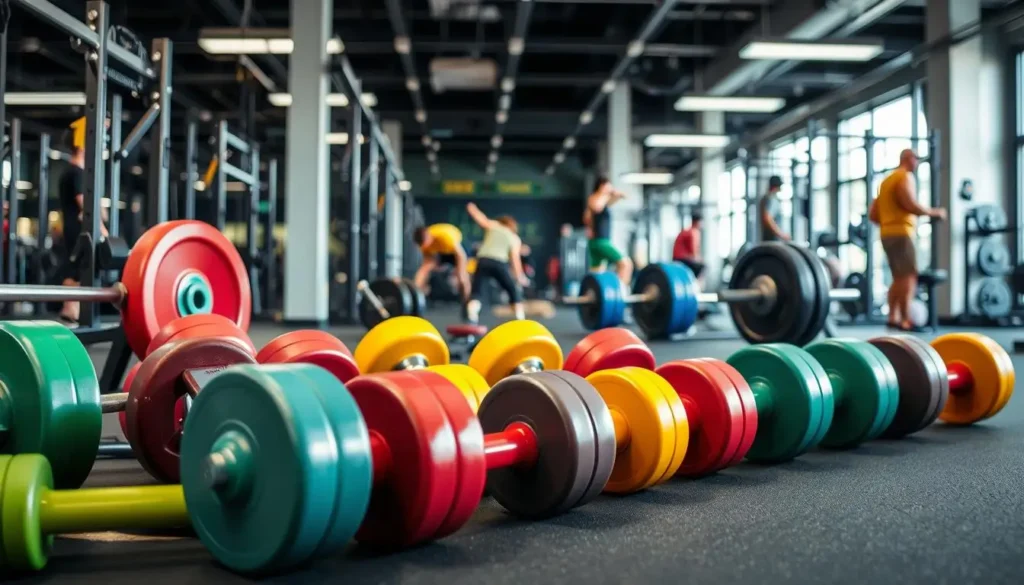
Free Weights vs. Resistance Machines
Building muscle and strength can be done with free weights and resistance machines. Free weights, like dumbbells and barbells, make you work harder to keep stable. This leads to stronger muscles. Resistance machines are good for beginners or those focusing on certain muscles and getting their form right.
Many argue over which is better for building muscle. But studies say mixing free weights and machines is best for full muscle growth. It’s all about what you want and need, especially for getting stronger.
Free weights need more coordination because they’re less stable. This can help grow more muscles than machines. But machines let you lift heavier, which can help get stronger, even if it doesn’t grow as much muscle.

Choosing between free weights and machines depends on what you like and what you’re trying to achieve. Using both can help you reach your goals in muscle building and strength training.
Structuring Your Workouts
Building strength and muscle needs a good workout plan. Think about the sets, reps, and training volume.
For growing muscles, do 3-4 sets of 8-12 reps for each exercise. Use weights that make you almost fail on the last few reps. This method works well for muscle growth. Keep getting stronger by adding more weight or reps over time.
Optimizing Sets, Reps, and Volume
Here are some tips for your workouts:
- Do 3-5 sets of each exercise for muscle or strength.
- For muscle or strength, aim for 3-12 reps in each set.
- For toning, do 2-3 sets with 12-20 reps.
Change your rest times based on your goals. Short rest (1-2 minutes) is good for muscle growth. Longer rest (3-5 minutes) is better for strength.
| Workout Goal | Sets | Reps | Rest Periods |
|---|---|---|---|
| Muscle Hypertrophy | 3-4 sets | 8-12 reps | 1-2 minutes |
| Strength Training | 3-5 sets | 3-5 reps | 3-5 minutes |
| General Fitness | 2-3 sets | 12-20 reps | 1-2 minutes |
Try different workout structures, sets and reps, and training volumes. Find what works best for you.
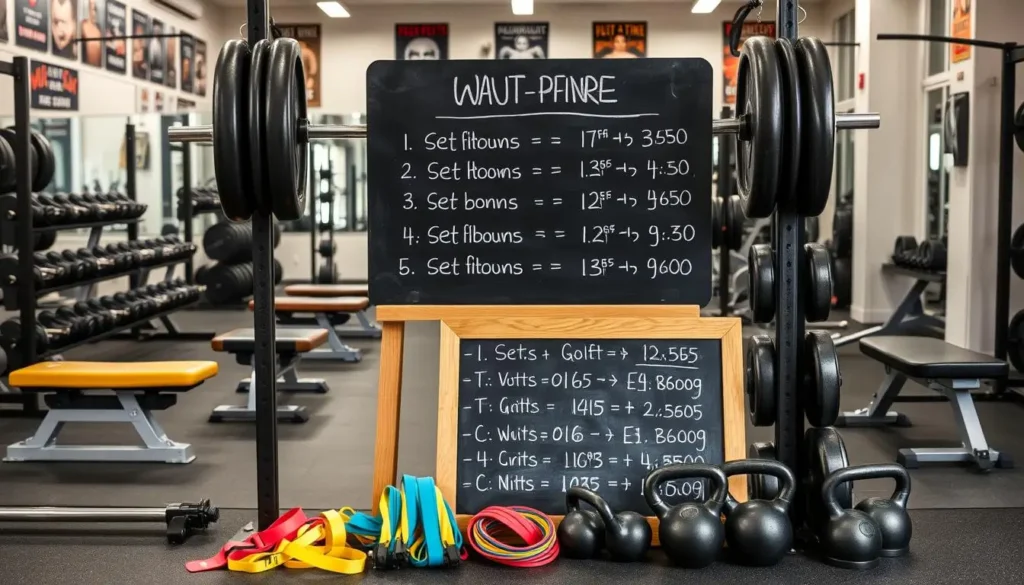
“The key to muscle growth is progressive overload – continuously challenging your muscles with heavier weights, more reps, or increased volume over time.”
The Role of Nutrition
Eating right is key for muscle growth and getting better. If you want to build muscle, eat a bit more than you need (5-10% more). Make sure you get enough protein from lean meats, eggs, dairy, and legumes. You need at least 1.4g of protein for every kilogram of your body weight.
Carbohydrates are also important. They help you work out and get better. Knowing the right mix of macronutrients can help you build muscle better.
Caloric Surplus and Macronutrient Ratios
Experts say you should eat 1.2-1.7 grams of proteins for every kilogram of your body weight. This helps your muscles repair and grow. Carbs should be 55%-60% of your daily calories to give you energy.
Healthy fats should be 25%-30% of your daily calories. They help with hormones and health.
Studies show eating protein after working out can make you less sore and help your muscles grow. Eating more protein can also make you stronger and more powerful.
Drinking enough water is also important. It helps you perform better and feel less tired. Eating carbs before a big event can help you have more energy.
“Eating a good diet can significantly help with performance in the gym. Aim for a diet that gives the energy needed to complete workouts and provides proper nutrition for recovery.”
Supplements like whey protein, BCAAs, and creatine can also help. They meet your protein needs, help you recover, and boost strength and muscle.
What you eat before a competition is very important. It helps you do your best.
Example Workout Plans
Creating a good muscle-building workout plan is key for those wanting to get stronger. Here’s a 6-day per week weightlifting routine to build muscle:
| Day | Workout |
|---|---|
| Monday | Chest and Triceps |
| Tuesday | Back and Biceps |
| Wednesday | Legs |
| Thursday | Shoulders and Traps |
| Friday | Arms (Biceps and Triceps) |
| Saturday | Full-Body Compound Exercises |
This routine hits each big muscle group twice a week. It helps with recovery and muscle growth through more weight. Beginners start with two to three cardio days and two strength days, then add more as they get better. Intermediate folks might add HIIT once or twice a week to boost their workouts.
For a simpler plan, try a full-body workout three times a week. A study showed two full-body workouts a week are as good as a four-day split routine for strength and muscle.
It’s important to keep adding weight, do exercises right, and rest well to grow muscle and get stronger. Rest is crucial for advanced folks to avoid injuries and burnout from too much intensity.
Adding these workout plans to your routine can help you reach your strength and muscle goals. Always listen to your body, tweak the plan if needed, and focus on safety and proper form to avoid injuries and get the best results.
Conclusion
Building muscle takes time, effort, and a good plan. Focus on the basics like how often to train and choosing the right exercises. Also, make sure you’re doing them right.
High-frequency training helps build strength. Eating right and doing resistance exercises can change your body shape. They help you lose fat and gain muscle.
Starting your muscle building journey? Stick with it and adjust as you go. Regular strength training boosts your health in many ways. It improves your heart, blood sugar, and mood.
Use weightlifting routines that fit you and follow hypertrophy training rules. This way, you can reach your best strength and confidence.
FAQ
What is muscular hypertrophy and how does it relate to progressive overload?
FAQ
What is muscular hypertrophy and how does it relate to progressive overload?
How important is rest and recovery for muscle growth?
FAQ
What is muscular hypertrophy and how does it relate to progressive overload?
FAQ
What is muscular hypertrophy and how does it relate to progressive overload?
How often should I train each muscle group for optimal muscle growth?
FAQ
What is muscular hypertrophy and how does it relate to progressive overload?
FAQ
What is muscular hypertrophy and how does it relate to progressive overload?
What types of exercises are best for building muscle?
FAQ
What is muscular hypertrophy and how does it relate to progressive overload?
FAQ
What is muscular hypertrophy and how does it relate to progressive overload?
What are the different approaches to structuring weightlifting workouts for muscle growth?
FAQ
What is muscular hypertrophy and how does it relate to progressive overload?
FAQ
What is muscular hypertrophy and how does it relate to progressive overload?
What are the benefits of using both free weights and resistance machines for muscle building?
FAQ
What is muscular hypertrophy and how does it relate to progressive overload?
FAQ
What is muscular hypertrophy and how does it relate to progressive overload?
What are the key factors to consider when structuring your weightlifting workouts for muscle growth?
FAQ
What is muscular hypertrophy and how does it relate to progressive overload?
FAQ
What is muscular hypertrophy and how does it relate to progressive overload?
How important is nutrition for supporting muscle growth and recovery?
FAQ
What is muscular hypertrophy and how does it relate to progressive overload?
FAQ
What is muscular hypertrophy and how does it relate to progressive overload?
7 On Air Fitness Routines to Elevate Your Home Workouts!
Transform your home workout experience with revolutionary on air fitness routines that deliver incredible results without stepping foot in a gym. Whether you’re a fitness enthusiast or just starting your wellness journey, these dynamic aerial-inspired exercises will elevate your strength, flexibility, and cardiovascular health to new heights.
Source Links
- The Workout Plan to Build Brute Strength and Power – Muscle & Fitness
- The Best Gym Workout Plan For Gaining Muscle
- The 10 Things You Have to Get Right to Build Muscle
- Ultimate Guide to Hypertrophy Training: Techniques, Nutrition, and RecoveryComprehensive Hypertrophy Training Guide
- Determination of Resistance Training Frequency
- Is There An Optimal Training Frequency and Volume?
- How To Build Your Own Workout Routine (Plans & Exercises)
- The Complete 4-Week Beginner’s Workout Program – Muscle & Fitness
- Workout Routines for Men: The Ultimate Guide
- Effect of free-weight vs. machine-based strength training on maximal strength, hypertrophy and jump performance – a systematic review and meta-analysis – BMC Sports Science, Medicine and Rehabilitation
- Free Weights Vs Resistance Machines – Which Is Better For You? – Sundried
- How to Build Your Own Workout Plan (+ Sample Template) | BarBend
- Here’s how to structure a gym workout | The Hussle Blog
- How to Structure a Gym Workout for Optimal Results | ISSA
- The Role of Nutrition in Strength Training – Science & Practical Tips – Booty Lab
- The Impact of Nutrition on Your Weightlifting Performance
- Workout Schedules: Weekly Samples for Each Fitness Level
- Split Workout Schedule: What To Know and Examples
- Strength Training Benefits | 110+ Stats & Facts | Research Review
- Strength training, also known as resistance training or weightlifting, is a highly effective and versatile form of exercise that offers a wide range of physical and mental benefits.

